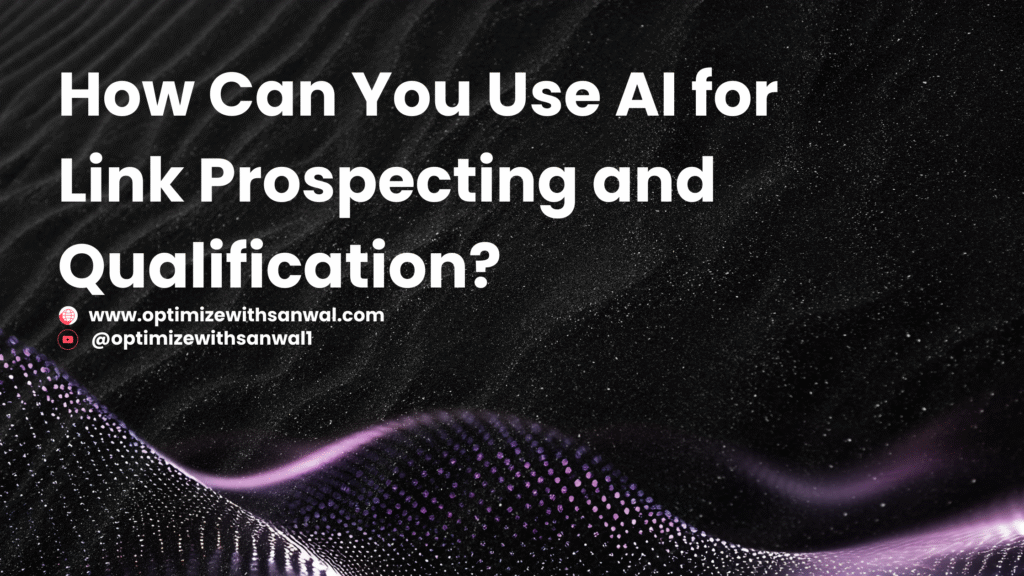As a link builder, you know the feeling. You spend an entire day digging through competitor backlink profiles and SERPs, building a list of 200 prospects. The next day, you start vetting them, only to realize that 150 are low-quality, irrelevant, or just plain spammy. It’s a massive waste of time.
This guide is a deep dive into the first, most critical stage of the outreach process I outlined in my main pillar, How Will AI Change the Future of Link Building and Digital PR?. I’m going to show you how I use AI for link prospecting to build better, more qualified lists in a fraction of the time.
Why is Traditional Prospecting So Inefficient?
The old way of automated prospect research often involved exporting a huge list based on a single metric, like Domain Authority. But we know that a high DA doesn’t always mean a site is a good fit. The real work—the manual vetting of each and every site for relevance and quality—is what takes all the time. This is the bottleneck that AI can help us solve.
My 3-Step Workflow for AI-Powered Prospecting
My process is about using AI not just to find sites, but to think like a link builder and help me qualify link prospects before I invest my time in them.
Step 1: Generate a Broad Prospect List
This first step is still the same. I use a standard SEO tool like Ahrefs or Semrush to generate a large, unvetted list of potential targets. Good sources include:
- Websites linking to a competitor’s similar article.
- Websites ranking on page 2 or 3 for my target keyword.
- Websites that have written about related, non-competing topics.
I export this list of URLs into a simple text file.
Step 2: Use the “AI Qualification” Prompt
This is where the magic happens. Instead of manually visiting each URL, I feed a batch of them to an AI with a specific set of instructions to act as my junior analyst.
Your Action: Use this expert-level prompt.
ROLE: You are a senior link building specialist with 10 years of experience, an expert at quickly qualifying outreach prospects for relevance and quality.
TASK: Analyze the following list of website URLs. For each one, determine its relevance and quality as a potential link prospect for my article about “[Your Topic]”.
CONTEXT: I need to quickly filter a large, raw list down to only the highest-quality, most relevant targets. My site is a professional business blog.
OUTPUT FORMAT:
A Markdown table with the following columns: “URL”, “Is it a good prospect? (Yes/Maybe/No)”, “Primary Site Type (e.g., Blog, News Site, Forum, SaaS)”, and “Justification (A 1-sentence explanation of your reasoning)”.
URL LIST:
[Paste your list of 20-50 URLs here]
The AI will return a clean table, instantly filtering out the low-quality or irrelevant sites, allowing me to focus only on the “Yes” and “Maybe” candidates.
Step 3: Use a Follow-Up Prompt to Find Contacts
Once I have my qualified list, I can use a follow-up prompt to speed up the process of finding the right person to contact.
Your Action: Take the “Yes” list from the previous step for this prompt.
ROLE: You are a smart research assistant skilled at finding contact information.
TASK: For each of the following URLs from my qualified prospect list, try to identify the name and job title of the best person to contact for a content partnership (e.g., the author, an editor, or a content manager).
OUTPUT FORMAT:
A list of URLs with the suggested contact person and their title next to it. If you cannot find a specific person, state “General contact form.”
URL LIST:
[Paste your qualified list of URLs here]
My Final Thoughts
Using AI for link prospecting is about shifting your mindset from “more is better” to “relevance is better.” This workflow lets you find link building opportunities with AI and, more importantly, qualify them before you invest any time in outreach. This leads to a more efficient process, a higher reply rate, and ultimately, better links.
About Me
I’m Sanwal Zia, a certified SEO strategist and the founder of Optimize with Sanwal. With expertise recognized by prestigious organizations, I focus on building effective search strategies that drive growth. You can connect with me on YouTube, my Website, LinkedIn, Facebook, and Instagram.


